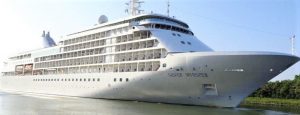 Following a day of sightseeing in Reykjavik, on Friday, July 15, 2022, we boarded Silversea’s Silver Whisper for a 12-day cruise that would take us around Iceland and through the Faroe, Shetland, and Orkney Islands. Following a stop in Edinburgh, Scotland, we would disembark at Greenwich, England; and, from there, be transported to London, one of the world’s most civilized and livable cities.
Following a day of sightseeing in Reykjavik, on Friday, July 15, 2022, we boarded Silversea’s Silver Whisper for a 12-day cruise that would take us around Iceland and through the Faroe, Shetland, and Orkney Islands. Following a stop in Edinburgh, Scotland, we would disembark at Greenwich, England; and, from there, be transported to London, one of the world’s most civilized and livable cities.
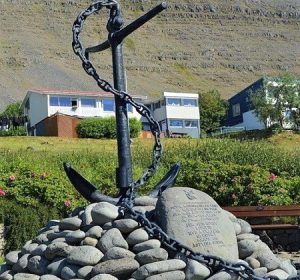 Patreksfordur, Iceland: A tiny village (population approximately 721) named after Patrick, bishop in the Hebrides, who was the spiritual guide of Őrlygur Hrappson, the original settler in the area. A majority of the inhabitants are engaged in some form of fishing. Those that are not tend to hold down several occupations… Like our guide, for example. He is both a teacher and an amateur magician; and, on this particular day, happened to be filling in for a friend as our guide. He was delightfully informative and possessed a great sense of humor.
Patreksfordur, Iceland: A tiny village (population approximately 721) named after Patrick, bishop in the Hebrides, who was the spiritual guide of Őrlygur Hrappson, the original settler in the area. A majority of the inhabitants are engaged in some form of fishing. Those that are not tend to hold down several occupations… Like our guide, for example. He is both a teacher and an amateur magician; and, on this particular day, happened to be filling in for a friend as our guide. He was delightfully informative and possessed a great sense of humor.
Perhaps the most moving part of our tour was the Memorial for Fishermen Lost at Sea (pictured). Located adjacent to the harbor area and inscribed in several languages, it is well worth a visit and moments of quiet meditation.
Our excursion concluded with a visit to a local restaurant and a mouth-watering tasting of several different varieties of local fish.
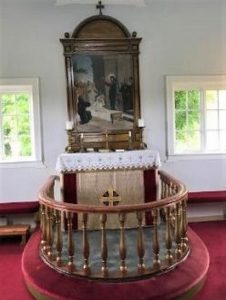 Akureyri, Iceland: Known as Iceland’s “Capital of the North,” Akureyri may be located a scant 60 miles from the Arctic Circle, but it blossoms with a certain cosmopolitan feel, especially during the summer months (the time of our recent visit). On this particular day, however, the weather was not the best – it rained the entire day – and our guide simply didn’t have her act together. Our excursion, however, was rather interesting…
Akureyri, Iceland: Known as Iceland’s “Capital of the North,” Akureyri may be located a scant 60 miles from the Arctic Circle, but it blossoms with a certain cosmopolitan feel, especially during the summer months (the time of our recent visit). On this particular day, however, the weather was not the best – it rained the entire day – and our guide simply didn’t have her act together. Our excursion, however, was rather interesting…
It began with a short bus ride to the Laufás Museum and Heritage Site, a renowned farm and church, the farm being an excellent example of a wealthy vicarage from earlier times. The Laufás Church was built in 1865 by Tryggvi Gunnarsson and Jóhann Bessason, and the furniture includes a pulpit constructed by Illugi Jónsson in 1698.
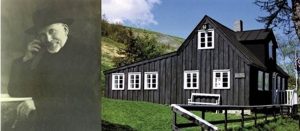 Following a short visit, we journeyed to Nonnahús – Nonni’s House, the childhood home of writer and Jesuit priest Jón Sveinsson, “Nonni” (1857 – 1944). Sveinsson wrote 12 children’s books about his childhood in Iceland. And, although he wrote in German, his books have been translated into more than 40 languages, including Chinese and Esperanto.
Following a short visit, we journeyed to Nonnahús – Nonni’s House, the childhood home of writer and Jesuit priest Jón Sveinsson, “Nonni” (1857 – 1944). Sveinsson wrote 12 children’s books about his childhood in Iceland. And, although he wrote in German, his books have been translated into more than 40 languages, including Chinese and Esperanto.
Nonni’s House, which was constructed in 1850, is one of the oldest houses in Akureyri; and it has been preserved as an example of a typical 19th century Icelandic town home. Visitors to the cozy museum are also treated to the only known moving pictures of Nonni, taken in Valkenburg, Netherlands in 1942.
Adjacent to Nonni’s House is the Akureyri Museum, which houses a rather intriguing hodge-podge collection of music, musical instruments, and fashion oddities.
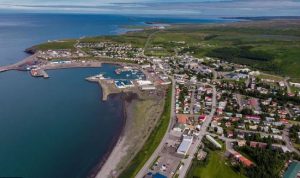 Húsavik, Iceland: Framed by the majestic Húsavikurfjail Mountain on the shores of Skjálfandi Bay on Iceland’s north coast, Húsavik is home to just over 2,300 inhabitants.
Húsavik, Iceland: Framed by the majestic Húsavikurfjail Mountain on the shores of Skjálfandi Bay on Iceland’s north coast, Húsavik is home to just over 2,300 inhabitants.
According to the Landnámabók (“Book of Settlement), Húsavik was the first location in Iceland to be settled by a Norseman. The Swedish Viking Garôar Svavarsson remained here for one winter in 870 A.D. When he departed the island in the spring of 870, he left behind a man named Náttfari and two slaves, a man and a woman, who established a farm here. The name Húsavik means “bay of houses,” and undoubtedly refers to Garôar’s homestead, which may have been the only house in Iceland at the time.
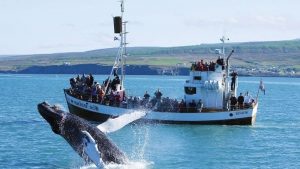 Income on the island is derived basically from tourism and fishing, as well as certain retail stores and small industries. With respect to tourism, however, Húsavik’s claim to fame is that it has become a center of whale watching in Iceland, due to the different species that frequently enter the bay. The day of our excursion, it was the humpbacks that took center stage, swimming remarkably close to our (rather small) boat and otherwise putting on an amazing diving exhibition for an enthusiastic crowd of novice seagoers.
Income on the island is derived basically from tourism and fishing, as well as certain retail stores and small industries. With respect to tourism, however, Húsavik’s claim to fame is that it has become a center of whale watching in Iceland, due to the different species that frequently enter the bay. The day of our excursion, it was the humpbacks that took center stage, swimming remarkably close to our (rather small) boat and otherwise putting on an amazing diving exhibition for an enthusiastic crowd of novice seagoers.
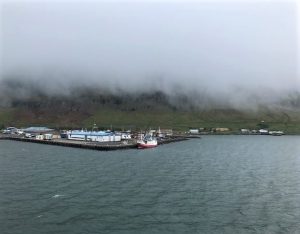 Seydisfjordur, Iceland: According to Frommer’s, this charming Icelandic village is nestled in an 11-mile fjord that is “lined with sheltering, snow-capped mountains and tumbling waterfalls.” Well… not quite. At least not the day of our visit. As you may clearly observe from the photograph, it was another one of those miserable rainy days… with all those charming “snow-capped mountains and tumbling waterfalls” totally obscured by a particularly pervasive low-cloud cover.
Seydisfjordur, Iceland: According to Frommer’s, this charming Icelandic village is nestled in an 11-mile fjord that is “lined with sheltering, snow-capped mountains and tumbling waterfalls.” Well… not quite. At least not the day of our visit. As you may clearly observe from the photograph, it was another one of those miserable rainy days… with all those charming “snow-capped mountains and tumbling waterfalls” totally obscured by a particularly pervasive low-cloud cover.
In fact, the weather was so downright miserable that all the morning excursions were cancelled. I had planned to take a dip in the Vök Nature Baths in the afternoon, but since the dismal rainy weather persisted, I decided to catch up on my notes instead. Unfortunately, the day was a complete washout.
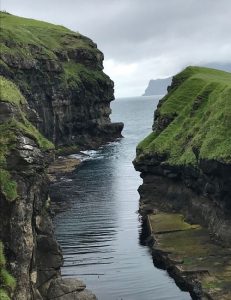 Runavik, Faroe Islands: Sandwiched between Norway and Iceland, this tiny cluster of 18 islands is something of an anomaly, as it is conspicuous by its absent from most itineraries, and generally overlooked – or ignored – by the peripatetic public. And this is truly unfortunate, as the Faroe Islands are utterly fascinating, to say the least.
Runavik, Faroe Islands: Sandwiched between Norway and Iceland, this tiny cluster of 18 islands is something of an anomaly, as it is conspicuous by its absent from most itineraries, and generally overlooked – or ignored – by the peripatetic public. And this is truly unfortunate, as the Faroe Islands are utterly fascinating, to say the least.
Runavik, on the southern tip of Eysturoy, the Faroe’s second-largest island, is the epitome of off-the-beaten-track travel. As we stepped off the ship, we were immediately engulfed by the staggering beauty of the unspoiled landscape.
Despite its small size and population (approximately 50,000), however, the Faroese aquaculture industry is recognized as the boutique producer specializing in top-quality Atlantic salmon in the world.
 The aquaculture industry in the Faroe Islands is committed to sustainability and sound stewardship of the environment. The industry worked closely with the Faroese Government to design and implement one of the most stringent aquaculture regulatory regimes governing veterinarian best practices in the world. The legislation ensures strict compliance with the highest level of fish welfare and environmental protection possible. This exclusive veterinary prevention program has been so effective that farmed salmon from the Faroe Islands are completely free of antibiotics. (Pictured: Runavik from the road above. Note the salmon farms in the upper left corner.)
The aquaculture industry in the Faroe Islands is committed to sustainability and sound stewardship of the environment. The industry worked closely with the Faroese Government to design and implement one of the most stringent aquaculture regulatory regimes governing veterinarian best practices in the world. The legislation ensures strict compliance with the highest level of fish welfare and environmental protection possible. This exclusive veterinary prevention program has been so effective that farmed salmon from the Faroe Islands are completely free of antibiotics. (Pictured: Runavik from the road above. Note the salmon farms in the upper left corner.)
The Faroese aquaculture industry has a long and proud history. And this heritage, combined with ideal natural conditions and a commitment to quality and sustainability, keeps Faroe Islands salmon, which is now exported to six continents, in extremely high demand. And farmed salmon is also a vital part of the Faroese economy, representing half of the country’s export while also providing valuable employment for rural communities.
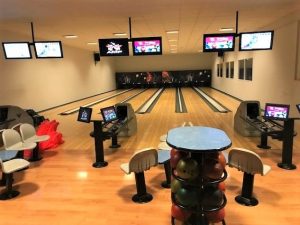 During our drive back to the ship, our excellent guide planned a brief stop for coffee and cake at a small restaurant cum bowling establishment. One of the last places in the world you’d expect to find bowling lanes… Only six, but I just couldn’t resist taking a pic for all you bowlers back home!
During our drive back to the ship, our excellent guide planned a brief stop for coffee and cake at a small restaurant cum bowling establishment. One of the last places in the world you’d expect to find bowling lanes… Only six, but I just couldn’t resist taking a pic for all you bowlers back home!
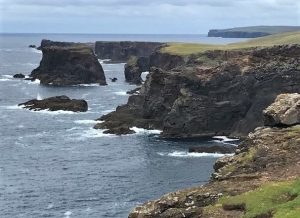 Lerwick, Shetland Islands, Scotland, U.K.: Situated between the Scottish and Norwegian coasts, just south of the Arctic Circle, the Shetland Islands are an archipelago in Scotland, United Kingdom, composed of over one hundred islands, fifteen of which are inhabited.
Lerwick, Shetland Islands, Scotland, U.K.: Situated between the Scottish and Norwegian coasts, just south of the Arctic Circle, the Shetland Islands are an archipelago in Scotland, United Kingdom, composed of over one hundred islands, fifteen of which are inhabited.
Spanning an intriguing Neolithic history and 5,000 years of human heritage, these isolated islands are immense treasure troves of both history and the scenic wonders of windswept beaches, rolling landscapes, and rugged coastlines. Our excursion for the day, for example, transported us to the breath-takingly jagged cliffs of the wild & woolly Eshaness Coast (pictured).
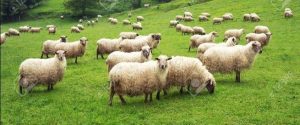 These islands are also home to the famous diminutive and wavy-fringed Shetland Ponies. Their presence here is a testimony to Viking history, as local horses bred with ponies brought ashore by Norse settlers created the crossbreed that is an icon of these islands today. They may be readily observed roaming freely on the rolling moors… But they are not nearly so plentiful as the sheep, which seem to be everywhere (approximately 150,000 compared to 25,000 inhabitants) – making many of the narrow roads nearly impassable – since there are no fences or other barriers to confine them.
These islands are also home to the famous diminutive and wavy-fringed Shetland Ponies. Their presence here is a testimony to Viking history, as local horses bred with ponies brought ashore by Norse settlers created the crossbreed that is an icon of these islands today. They may be readily observed roaming freely on the rolling moors… But they are not nearly so plentiful as the sheep, which seem to be everywhere (approximately 150,000 compared to 25,000 inhabitants) – making many of the narrow roads nearly impassable – since there are no fences or other barriers to confine them.
Kirkwall, Orkney Islands, Scotland, U.K.: Scattered just off the northern tip of Scotland, the Orkney Islands may be physically close to the United Kingdom but, they feel a world away.
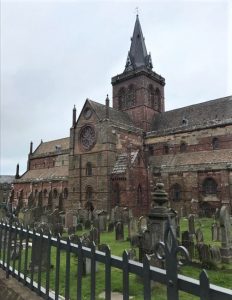 The centerpiece of Kirkwall, the capital of this scenic archipelago, is the majestic St. Magnus Cathedral, which was founded by Earl Rognvald, nephew of St. Magnus, the Earl of Orkney, in the early 1100s. Construction of Britain’s northernmost cathedral began in 1137 and took 300 years to complete. When first built, the cathedral was part of the Archdiocese of Nidaros (Trondheim) in Norway.
The centerpiece of Kirkwall, the capital of this scenic archipelago, is the majestic St. Magnus Cathedral, which was founded by Earl Rognvald, nephew of St. Magnus, the Earl of Orkney, in the early 1100s. Construction of Britain’s northernmost cathedral began in 1137 and took 300 years to complete. When first built, the cathedral was part of the Archdiocese of Nidaros (Trondheim) in Norway.
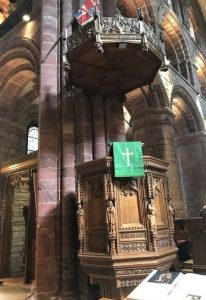 Orkney became part of Scotland in 1468 and, a few years later, the cathedral was given to the people of Kirkwall by the Scots King, James III. After the Scottish Reformation in 1560, the cathedral was used for Protestant worship. Today, the cathedral belongs to the people of Orkney and is looked after by the Orkney Islands Council. It has a Church of Scotland congregation; and, by arrangement, can be used by any Christian denomination.
Orkney became part of Scotland in 1468 and, a few years later, the cathedral was given to the people of Kirkwall by the Scots King, James III. After the Scottish Reformation in 1560, the cathedral was used for Protestant worship. Today, the cathedral belongs to the people of Orkney and is looked after by the Orkney Islands Council. It has a Church of Scotland congregation; and, by arrangement, can be used by any Christian denomination.
Restoration works took place in the 1850s and again from 1913 – 1930 following a large bequest from Sheriff George Thomas, when the present floors, woodwork, stained glass windows and spire, were installed. The cathedral has been evocatively named as the Light in the North.
So much for the Sacred… now for the Profane (with apologies to Mircea Eliade, Romanian historian of religion, fiction writer, philosopher, professor at the University of Chicago, and author of The Sacred and the Profane: The Nature of Religion) and those infamous mists of the Scottish moors…
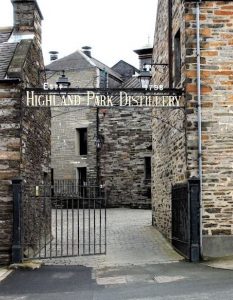 The Highland Park Distillery, one of the oldest working distilleries in Scotland, was founded by Magnus Eunson, a butcher and church officer by day and illicit distiller and whisky smuggler by night. In 1798 he was caught illegally distilling whisky on the site (There are numerous legends about the extent to which illicit distilling was occurring on Orkney, many of which involve accounts of the mayor of Kirkwall, the capital of Orkney, being a major smuggler!).
The Highland Park Distillery, one of the oldest working distilleries in Scotland, was founded by Magnus Eunson, a butcher and church officer by day and illicit distiller and whisky smuggler by night. In 1798 he was caught illegally distilling whisky on the site (There are numerous legends about the extent to which illicit distilling was occurring on Orkney, many of which involve accounts of the mayor of Kirkwall, the capital of Orkney, being a major smuggler!).
The first license to distill whisky was granted to Highland Park in 1826, with Robert Borwick overseeing production. The Borwick family-maintained control until 1895, when it was purchased by James Grant, the owner of Glenlivet Distillery. In 1937 the site was purchased by Highland Distillers who, in 1979, initiated a different marketing strategy. Instead of using the majority of their production for blending, they decided to market Highland Park as Single Malt, which increased sales enormously. The Highland Park visitor’s center opened in 1986. In 1999 the Erdington Group and William Grant & Sons acquired Highland Distillers and initiated a multi-million-dollar renovation of both the distillery and the visitor’s center.
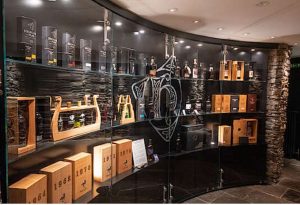 As well as being one of Scotland’s oldest distilleries, Highland Park also has the distinction of being the most northerly distillery in Scotland. And it produces an impressive range of official bottlings… 12-year-old, 18-year-old, 21-year-old, 25-year-old, 30-year-old and 40-year-old. The distillery also offers a series of special bottlings, which includes the “Valhalla” range, editions named after the Norse mythological gods, as well as an Orcadian Series, which is currently comprised of 1964, 1968, 1970, 1971, and 1976 bottlings. Highland Park is also used as a major component in the Famous Grouse whisky blend.
As well as being one of Scotland’s oldest distilleries, Highland Park also has the distinction of being the most northerly distillery in Scotland. And it produces an impressive range of official bottlings… 12-year-old, 18-year-old, 21-year-old, 25-year-old, 30-year-old and 40-year-old. The distillery also offers a series of special bottlings, which includes the “Valhalla” range, editions named after the Norse mythological gods, as well as an Orcadian Series, which is currently comprised of 1964, 1968, 1970, 1971, and 1976 bottlings. Highland Park is also used as a major component in the Famous Grouse whisky blend.
After a tour of the facilities, we finally got down to more important matters – like the tastings! We sampled two of the distillery’s bottlings, the 12-year-old and the 18-year-old. While the former was a bit on the sharp side, the 18-year-old was velvet on the palate and as smooth as silk going down.
Introduced to the Highland Park portfolio in 1997, the 18-year-old was named “Best Spirit in the World” in the Spirit Journal on two separate occasions. The intense balance of flavors is the result of the distillery’s five traditional keystones of production, honored for over 220 years: slow-burning, aromatic peat from Hobbister Moor; hand-turned floor maltings (which our group personally observed); sherry-seasoned European oak casks; cool maturation in a temperate island climate; and a decidedly unhurried process of harmonization.
If you are a devotee of fine Scotch whisky, you should definitely give Highland Park 18-year-old a try. According to my latest research, it is listed at $164.99 for the 750 ML bottle in Pennsylvania State Stores… Unfortunately, it is out of stock (What else is new???). It is readily available online for a variety of different price points (plus shipping).
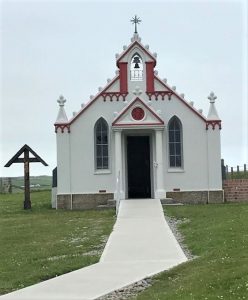 The final stop on our excursion was a visit to Orkney’s famous Italian Chapel. Apart from the nearby statue of St. George, the Chapel is the only relic of Camp 60, which, in the latter years of the Second World War, housed several hundred Italian prisoners. These men, captured during the North African campaign, were sent to Orkney to work on the Churchill Barriers, a massive series of concrete causeways that seal the eastern approaches to Scapa Flow (a natural harbor located off the coast of Scotland, United Kingdom).
The final stop on our excursion was a visit to Orkney’s famous Italian Chapel. Apart from the nearby statue of St. George, the Chapel is the only relic of Camp 60, which, in the latter years of the Second World War, housed several hundred Italian prisoners. These men, captured during the North African campaign, were sent to Orkney to work on the Churchill Barriers, a massive series of concrete causeways that seal the eastern approaches to Scapa Flow (a natural harbor located off the coast of Scotland, United Kingdom).
At first, the camp consisted of thirteen generic huts; but the Italian prisoners made concrete paths and planted flowers, completely transforming their surroundings. To preside over the camp “square,” an artistic prisoner named Domenico Chiocchetti, made the figure of St. George, built up from a framework of barbed wire covered with cement.
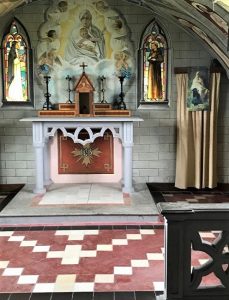 At this point, the only thing the camp still lacked was a chapel, which was deeply felt by the prisoners, and the construction of which had been urged by the War Office Inspector of P.O.W. Camps. To whom the credit for the ambitious idea of building a chapel should ultimately be assigned remains something of a mystery. One point is certain, however… It developed as a natural outcome of the goodwill of the commandant, the pastoral concern of Father P. Gioacchino Giacobazzi, and the genius of the aforementioned Domenico Chiocchetti and his fellow prisoners. Who could possibly have foreseen that, under their hands, a building would be constructed that is still a thing of beauty and an inspiration to countless visitors.
At this point, the only thing the camp still lacked was a chapel, which was deeply felt by the prisoners, and the construction of which had been urged by the War Office Inspector of P.O.W. Camps. To whom the credit for the ambitious idea of building a chapel should ultimately be assigned remains something of a mystery. One point is certain, however… It developed as a natural outcome of the goodwill of the commandant, the pastoral concern of Father P. Gioacchino Giacobazzi, and the genius of the aforementioned Domenico Chiocchetti and his fellow prisoners. Who could possibly have foreseen that, under their hands, a building would be constructed that is still a thing of beauty and an inspiration to countless visitors.
After the war, the entire camp, apart from paths and hut foundations, disappeared; but the chapel (and St. George with his dragon) remained. And, over the course of time, it has become a place of pilgrimage for anyone visiting in Orkney.
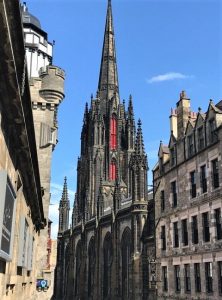 Edinburgh, Scotland, U.K.: Recognized as the capital of Scotland since the 15th century, Edinburgh is the seat of the Scottish government, the Scottish Parliament, and the highest courts in Scotland. In addition, the city has long been a center of education, particularly in the fields of medicine, Scottish law, literature, philosophy, the sciences, and engineering.
Edinburgh, Scotland, U.K.: Recognized as the capital of Scotland since the 15th century, Edinburgh is the seat of the Scottish government, the Scottish Parliament, and the highest courts in Scotland. In addition, the city has long been a center of education, particularly in the fields of medicine, Scottish law, literature, philosophy, the sciences, and engineering.
As Charlotte Bronte once wrote, Edinburgh is to London as poetry is to prose. One of the world’s stateliest cities and proudest capitals, it is built – like Rome – on seven hills, making it a magnificent backdrop for the ancient pageant of history. Despite its rich past, however, it is also a modern city of lively festivals, excellent museums, and galleries filled with beautiful works of art. Edinburgh’s Old Town and New Town together are listed as a UNESCO World Heritage Site, which has been managed by Edinburgh World Heritage since 1999.
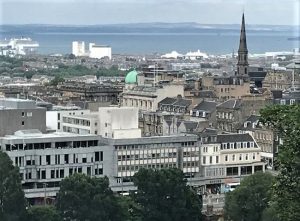 Our day’s excursion took us by bus through the New and beautiful Old City, ending with a visit to the Edinburgh Castle. Situated on a volcanic crag called the Castle Rock, this majestic stronghold, former residence of Scottish monarchs, stands 443 feet above sea level, overlooking the city of Edinburgh (Pictured: View from Castle Rock).
Our day’s excursion took us by bus through the New and beautiful Old City, ending with a visit to the Edinburgh Castle. Situated on a volcanic crag called the Castle Rock, this majestic stronghold, former residence of Scottish monarchs, stands 443 feet above sea level, overlooking the city of Edinburgh (Pictured: View from Castle Rock).
Castle Rock has been the site of human activity for at least 3,000 years. The first king of Scotland known to have made his residence here was Malcom III Canmore (reigned 1058-93). His wife, Queen Margaret, who died in the castle in 1093 and was later canonized as St. Margaret of Scotland, is commemorated in St. Margaret’s Chapel, which was built between 1130 and 1140 on the highest point of the rock and is the oldest surviving building on the castle grounds. The last monarch to stay overnight in Edinburgh Castle was Charles I in 1633.
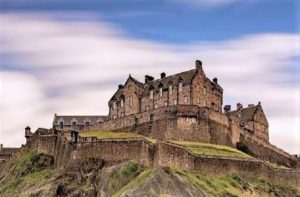 The castle was repeatedly besieged during the 17th and early 18th centuries. It was captured twice, briefly, by Covenanters during the Bishops’ Wars of 1639 and 1640 and was seized by Oliver Cromwell’s New Model Army in 1650 during the English Civil Wars. Between 1757 and 1814, the castle housed prisoners of war taken by the British in the Seven Years’ War, the American Revolution, and the Napoleonic Wars. Still in use by the British military are the New Barracks (1796-99). Elsewhere on the castle grounds, Scotland honors it military tradition in the Scottish National War Memorial (opened 1927) and the National War Museum (opened 1933). The castle is the traditional repository of the Honours of Scotland, the country’s crown jewels. A more ancient relic of Scottish royalty is the Stone of Scone (or Stone of Destiny), which arrived at the castle in 1996, exactly 700 years after it was removed to England. The stone is a block of sandstone upon which Scottish monarchs were traditionally crowned.
The castle was repeatedly besieged during the 17th and early 18th centuries. It was captured twice, briefly, by Covenanters during the Bishops’ Wars of 1639 and 1640 and was seized by Oliver Cromwell’s New Model Army in 1650 during the English Civil Wars. Between 1757 and 1814, the castle housed prisoners of war taken by the British in the Seven Years’ War, the American Revolution, and the Napoleonic Wars. Still in use by the British military are the New Barracks (1796-99). Elsewhere on the castle grounds, Scotland honors it military tradition in the Scottish National War Memorial (opened 1927) and the National War Museum (opened 1933). The castle is the traditional repository of the Honours of Scotland, the country’s crown jewels. A more ancient relic of Scottish royalty is the Stone of Scone (or Stone of Destiny), which arrived at the castle in 1996, exactly 700 years after it was removed to England. The stone is a block of sandstone upon which Scottish monarchs were traditionally crowned.
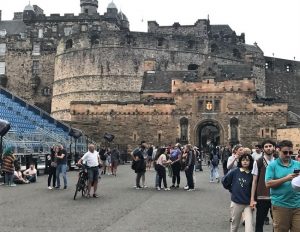 Just outside the castle drawbridge is a large open area called the Edinburgh Castle Esplanade (pictured), where grandstand seating is installed annually for an international military music festival called the Royal Edinburgh Military Tattoo and for other summer concerts.
Just outside the castle drawbridge is a large open area called the Edinburgh Castle Esplanade (pictured), where grandstand seating is installed annually for an international military music festival called the Royal Edinburgh Military Tattoo and for other summer concerts.
The day of our excursion to Edinburgh, in addition to our rather small vessel, which accommodates a mere 382 passengers, there were two other larger ships (approximately 2,000 passengers each) anchored in the harbor. So, as you will note from the photograph, the esplanade was something of a mob scene.
Greenwich, England, U.K.: Following two days at sea, we disembarked in Greenwich and were transported to London, where we spent four days taking in the sights, exploring the West End theater district, and ingesting the city’s extraordinarily diverse culinary culture (articles to follow).
Bon Appétit!
Be Safe & Stay Well
TAD

{ 0 comments… add one now }